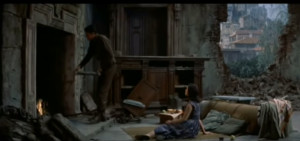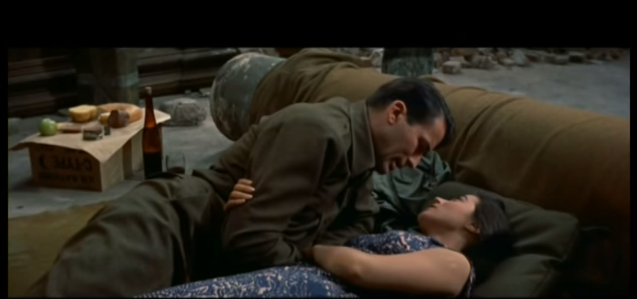Wilson’s The Man in the Gray Flannel Suit and Johnson’s film strongly solidified the character of Tom Wrath as a symbol of mid-twentieth Century America, the rising generation of white, well-educated men striving for wealth and power in mid-century 19th century America. Ernest Hemingway disdained Wilson’s novel as a drivel but was silent about the film.
A pivotal episode is a lovers’-picnic-in-a a ruined villa. Taking time off from soldiering during the Allied invasion of Italy, a married American army officer Captain Tom Rath thinks it’s the happiest day of his life as he drives in the rain on a date with Maria. As married soldiers sometimes do in the war, they engage with local women for sport and enjoyment. Rath is no exception, but the consequences of this dalliance are profound.
After wandering, Rath and Maria stumble into a deserted villa. Settling in the ruined library, Rath lights a fire, before which they spread an old tapestry. Rath lights a fire in the hearth, a blanket on the floor, and a basket of cold roast chicken, sandwiches, and wine.

When they are finished, Maria reminds Rath that they ought to make love. Slowly Maria unbuttons her jacket and opens her blouse, partly exposing her breasts. Rath cries, “Oh, God. I love you.” (It’s unknown what he says about the rest of Maria.)
It’s unmistakable that the picnic in the ruined villa is a metaphor for their future together. When Rath moves on as soldiers must, Maria is left alone and pregnant, and passion has run its course.
Rath doesn’t know about the pregnancy until years later. By then, he is reunited with his wife.
Featured Image: Gregory Peck as Tom Rath and Marisa Pavan as Maria Montagne
See Sloan Wilson. The Man in the Gray Flannel Suit. New York: Simon and Schuster, 1955; Nunnally Johnson. The Man in the Gray Flannel Suit (1956). Screenplay by Nunnally Johnson is based on Sloan Wilson’s novel, Ernest Hemingway. November 14, 1955, in Selected Letter 1917-1961. Edited by Carlos Baker. New York: Charles Scribner’s Sons, 1981

